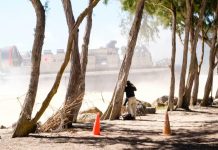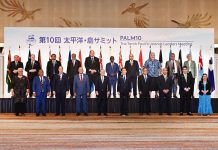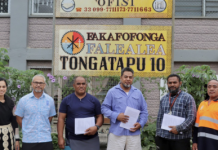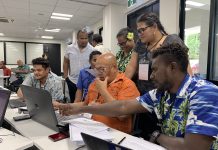The goal to effectively manage protected and conserved areas in the Pacific has taken an important step forward with the soft launch of the Comparative Analysis of Protected Area Management Effectiveness (PAME) evaluation tools for the region.
PAME Evaluations are tools to assess how well protected and conserved areas are being managed, primarily the degree to which management is safeguarding values and achieving goals and objectives.
Supporting effective management is an important step forward for the Pacific islands region, which has a combined EEZ area of more than 30 million square kilometres and is characterised by high biodiversity values and ecosystem diversity. Pacific island Peoples rely on the land and sea to sustain their livelihoods, maintain traditional knowledge and practices, and support national economies.
However, the Pacific islands are also under threat by unsustainable exploitation of natural resources, weak development planning, invasive species, population growth and pollution, the impacts of which have been exacerbated by the effects of global climate change.
Speaking during the launch hosted virtually by the Secretariat of the Pacific Regional Environment Programme (SPREP) on Friday, the Officer in Charge of SPREP’s Island and Ocean Ecosystems (IOE) programme, Amanda Wheatley, said the findings and recommendations of this Comparative Analysis would provide insights into current experience, lessons and best practice with adapting tools and undertaking PAME evaluations across the region, noting that it is also the first step in documenting, sharing, and upscaling knowledge on the state of PAME in the region.
“Our protected and conserved areas were established to protect the best of our natural terrestrial, coastal and marine areas and the diversity of species they support. They are also key tools for demonstrating sustainable use, climate change adaptation and for bolstering ecosystem health and community resilience. These areas are our key legacy to gift to future generations of Pacific islanders,” Wheatley said.
“The last eleven years has witnessed a notable increase in the establishment and formal designation of protected and conserved areas across the Pacific islands’ region, with nearly 20 percent of marine protected areas having been designated within EEZs since 2010.
“Despite this encouraging trend, only a few of these areas are adequately managed, which reinforces the point that achieving designated protection of a defined area should not end the process of support to sustain effective management.”
Wheatley acknowledged the partnership between the European Commission, the ACP Secretariat, UN Environment and FAO, which has resulted in the ACPMEAs Phase III project. She also acknowledged the EU-OACPS BIOPAMA programme, UN Environment (UNEP) and the IUCN Oceania Regional Office (IUCN ORO), key partners for this initiative.
“According to a forthcoming report on the status of protected and conserved areas in Oceania, less than 20 percent of protected sites across the region have undertaken protected area management effectiveness (PAME) evaluations,” Wheatley added. “This situation, while encouraging, still highlights a key gap in improving our current state of knowledge – as to whether our protected and conserved areas are in fact meeting the objectives for which they were primarily established and designated. Providing an answer to this significant question in a proactive manner is the core focus and intention of PAME evaluations. I am confident that this initial guidance will inform, inspire and catalyse further action for effective management of our important landscapes and seascapes.”
Wheatley’s optimism was shared by Dr. Balakrishna Pisupati, of the UN Environment Programme and Sally Bailey , of IUCN Oceania Regional Office (ORO) , who also delivered remarks during the launch.
Dr Pisupati highlighted the key partnership between the ACPMEAs3 project and the BIOPAMA programme which has facilitated the development of this Comparative Analysis, which he added, was relevant to current initiatives and processes including the 30×30 protected area target in relation to the Post-2020 Global Biodiversity Framework, the intergovernmental negotiating committee (INC) on plastics, and their regional seas programme.
Bailey said the PAME Evaluation Tools will help to develop a strategy going forward and continuing to build capacity in the region for management effectiveness of protected and conserved areas.
Looking back over a 10-year period, she noted that between 2010 and 2020, 226 PAME assessments were undertaken across 150 protected areas in the region, which is approximately 17% of the protected area in the region.
“The main tool to date that has been utilised in Oceania has been the Management Effectiveness Tracking tool or METT, which has been applied in 8 countries across the region. A key challenge is finding the right solutions and some countries have adapted global tools such as the METT. It is clear that the tools exist, whilst some may need adaptation to fit the unique circumstances of our Pacific countries to ensure effective management,” Bailey said.
“Whilst BIOPAMA, has enabled developing capacity in the region through training, and through its on granting facility (Action Component), has been able to assist countries in utilising, and in some cases adapting PAME tools such as METT, there is still a long way to go, however, I am confident that the findings and recommendations from this Analysis will provide essential guidance and direction on the way forward. We look forward to continuing to work closely with SPREP in this vital area of management effectiveness of protected and conserved areas for the region.”
The Comparative Analysis of Protected Areas Management Effectiveness (PAME) Evaluation Tools for the Pacific Islands’ region was developed by the Micronesia Conservation Trust (MCT) under contract to SPREP through assistance of the ACPMEAs 3 Project. Technical and advisory inputs were provided through assistance of the EU-OACPS BIOPAMA programme. The ACPMEAs 3 project, The ACP MEAs programme is a joint partnership between the European Union, the Organization of African, Caribbean and Pacific States (OACPS), UN Environment Programme (UNEP) and the Food and Agriculture Organization of the United Nations (FAO). The programme aims to build capacity in 79 countries in Africa, Caribbean and the Pacific (ACP) to support them in fulfilling their obligations as parties to Multilateral Environmental Agreements (MEAs), to address the environmental challenges they face and to reap the benefits of improved environmental governance at national and regional levels.
The BIOPAMA Programme, an initiative of the Organisation of African, Caribbean and Pacific (OACPS) Group of States financed by the European Union 11th European Development Fund. In the Pacific, the project is implemented by IUCN Oceania in partnership with SPREP and the European Commission Joint Research Centre.
This partnership has assisted the SPREP Regional Programme of Support for Protected Areas (SPREP-PA) to become a decision-making support hub, including delivering capacity building activities and training in the use of BIOPAMA support tools and services. It has also seen significant enhancements of the Pacific Islands Protected Area Portal, the region’s one-stop resource for protected area information.
For more information on the ACPMEAs 3 project, please contact Anastacia Amoa-Stowers, Multilateral Environmental Agreements (MEAs) Coordinator on email: anastacias@sprep.org
To learn more about the BIOPAMA regional decision-making support hub, please contact Vainuupo Jungblut, Protected Areas Officer on email: vainuupoj@sprep.org
SOURCE: SPREP/PACNEWS


















